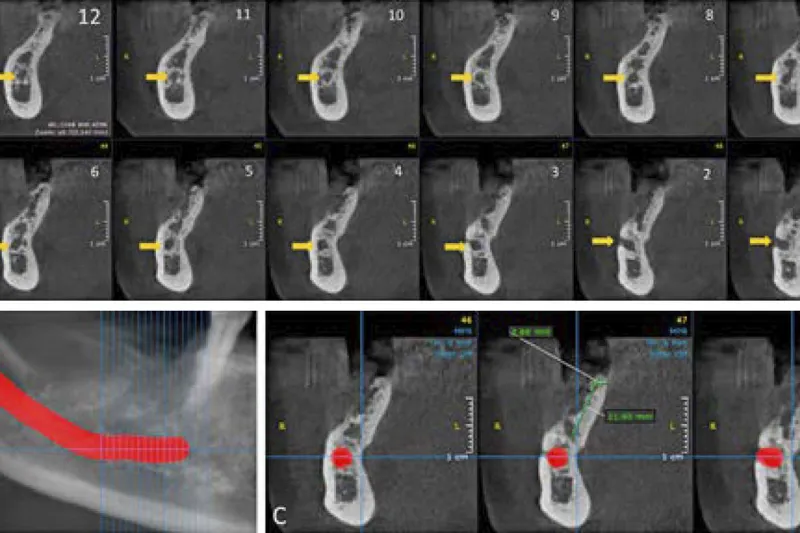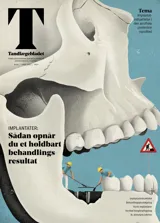Behandlingsplanlægning i forbindelse med implantatindsættelse i den atrofiske posteriore mandibel med fokus på den radiologiske undersøgelse
Omhyggelig behandlingsplanlægning er afgørende for valg af relevant behandlingsmodalitet og at gennemføre behandlingen med et forudsigeligt og sikkert behandlingsresultat med god langtidsprognose og mindst mulig risiko for komplikationer.

Atrofi af den posteriore mandibel byder på udfordringer, når en eller flere manglende tænder ønskes erstattet med en implantatbaseret protetisk restaurering. Behandlingsstrategi afhænger af flere faktorer, herunder dimensionerne af processus alveolaris samt beliggenheden af relevante anatomiske strukturer i mundbunden og mandiblen. Lokalisation af canalis mandibulae er således yderst vigtigt i forbindelse med implantatindsættelse i den atrofiske posteriore mandibel, da intraoperativ beskadigelse af n. alveolaris inferior vil medføre neurosensoriske forstyrrelser bl.a. svarende til hagen og underlæben. Omhyggelig behandlingsplanlægning inklusive radiologisk identifikation af canalis mandibulae er derfor afgørende for valg af relevant behandlingsmodalitet ved protetisk rehabilitering af den atrofiske posteriore mandibel og at gennemføre behandlingen med et forudsigeligt og sikkert behandlingsresultat med god langtidsprognose og mindst mulig risiko for komplikationer. I nærværende oversigtsartikel gennemgås forskellige metoder til vurdering af det tandløse område posteriort i mandiblen før implantatbehandling, herunder røntgenundersøgelse med særlig fokus på anvendelse af CBCT til lokalisering af canalis mandibulae.
Klinisk relevans:
Omhyggelig behandlingsplanlægning er en forudsætning for at kunne vælge den bedst mulige behandlingsstrategi i forbindelse med implantatbaseret protetisk behandling og at opnå et forudsigeligt og sikkert behandlingsresultat med en god langtidsprognose og mindst mulig risiko for komplikationer. Atrofi af den posteriore del af mandiblen giver ekstra udfordringer for behandleren, da reduceret bredde af processus alveolaris og mindsket afstand til canalis mandibulae kan vanskeliggøre implantatindsættelsen og fordre anvendelse af alternative behandlingsmetoder. I den sammenhæng er det vigtigt at have viden om relevante kliniske og radiologiske undersøgelsesmetoder, herunder styrker og svagheder, samt at vælge og udføre undersøgelserne ud fra de anbefalede retningslinjer.Treatment planning in relation to implant placement in the atrophic posterior mandible with focus on the radiographic examination
Atrophy of the posterior mandible presents challenges, when one or more teeth are to be replaced with an implant-based prosthetic restoration. The treatment strategy is influenced by several factors, including the dimensions of the alveolar ridge as well as the location of relevant anatomical structures in the floor of the mouth and the mandible. Localization of the mandibular canal is therefore of utmost importance in relation to implant placement in the atrophic posterior mandible since injury to the inferior alveolar nerve may cause neurosensory disturbances of the chin and lower lip. Thus, careful treatment planning, including radiological identification of the mandibular canal is essential for the selection of relevant treatment modality for prosthetic rehabilitation of the atrophic posterior mandible as well as conducting the treatment with a predictable and safe treatment outcome with a good long-term prognosis and the lowest risk of complications. In the present review, various methods for assessment of the edentulous area in the posterior mandible prior to implant treatment, including radiographic examination with special focus on the use of CBCT for localization of the mandibular canal are presented.


